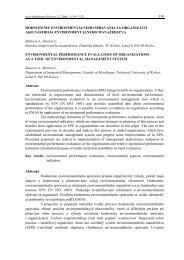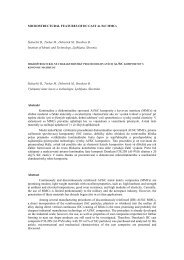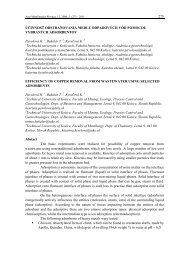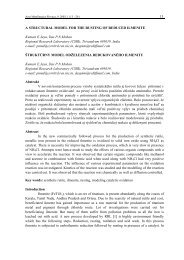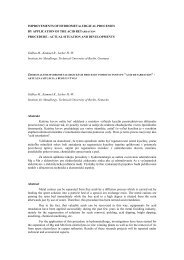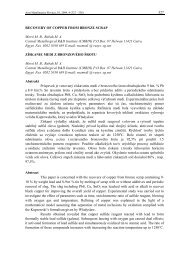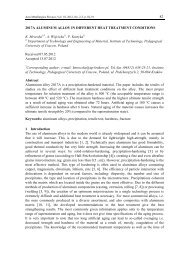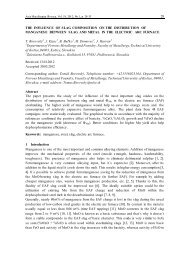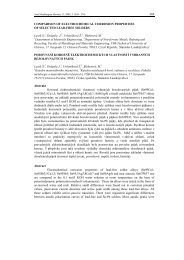4 EFFECT OF SEVERE PLASTIC DEFORMATION ON THE ...
4 EFFECT OF SEVERE PLASTIC DEFORMATION ON THE ...
4 EFFECT OF SEVERE PLASTIC DEFORMATION ON THE ...
You also want an ePaper? Increase the reach of your titles
YUMPU automatically turns print PDFs into web optimized ePapers that Google loves.
Acta Metallurgica Slovaca, Vol. 16, 2010, No. 1, p. 4-11 10the powder particles are plastically deformed and increasingly deformation strengthened.Implementation of debinding process tends to generate larger pores in the microstructure,because of the lower densification attained on the green parts. When back pressure is applied,the stress distribution in deformed specimens causes the powder particles to squeeze together tosuch an extent that the initially interconnected pores transform to small isolated pores,determining a lower value of parameter D circle . Consequently, ECAP-BP influences the porositydistribution in terms of the severe shear deformation involving and therefore influences the poremorphology which is represented by both parameters of f shape and f circle .4 Conclusions1. Pore diameters for all processes materials are in the range of 1 to 45 µm; however mostof the pores diameter values D circle are in the range of 2 to 10 µm. It could be expectedthat this large amount of small pores influences strongly both f shape and f circle .2. Pore profile irregularity, represented by morphological parameter f circle , is in the rangeof 0.23 to 0.25 and depicts an evolution of pores to a smooth contour that is moreeffective than to a circular form during sintering, so the highest value of f shape (as a poreelongation is in the range from 0.5 to 0.6) was registered for sintered and ECAPed-BPspecimen as well.3. ECAP-BP influences the porosity distribution in terms of the severe shear deformationinvolved and therefore influenced the pore morphology along with pore distribution.AcknowledgementsThis work is supported by Slovak Research and Development Agency - Bilateral Project SK-PL-0011-09. R. Bidulský thanks the Politecnico di Torino and the Regione Piemonte for co-fundingby the fellowship.References[1] R. Cook, I. T. H. Chang, C. L. Falticeanu: Materials Science Forum, Vol. 534-536, 2007, p.773-776.[2] M. Hull: Powder Metallurgy, Vol. 40, 1997, No. 2, p. 102-103.[3] H. Danninger, H. C. Neubing, J. Gradl: Sintering of High Strength Al-Zn-Mg-Cu Alloys toControlled Dimensions, In: PM’98 Granada, EPMA, Shrewsbury, Vol. 5, 1998, p. 272-277.[4] M. Fujda, M. Vojtko: Acta Metallurgica Slovaca, Vol. 13, 2007, SI., p. 585-591.[5] T. Kvačkaj, M. Fujda, O. Milkovič, M. Besterci: High Temperature Materials andProcesses, Vol. 27, 2008, No. 3, p. 193-202.[6] J. Bidulská, T. Kvačkaj, R. Bidulský, M. Actis Grande: High Temperature Materials andProcesses, Vol. 27, 2008, No. 3, p. 203-207.[7] M. Besterci, K. Sülleiová, T. Kvačkaj: Kovove Materialy, Vol. 46, 2008, No. 5, p. 309-311.[8] M. Besterci, T. Kvačkaj, L. Kováč, K. Sülleiová: Kovove Materialy, Vol. 44, 2006, No. 2,p. 101-106.[9] R. Y. Lapovok: Journal of Materials Science, Vol. 40, 2005, No. 2, p. 341-346.[10] J. Bidulská, T. Kvačkaj, R. Bidulský, M. Actis Grande: Kovove Materialy, Vol. 46, 2008,No. 6, p. 339-344.[11] R. Z. Valiev, R. K. Islamgaliev, I. V. Aleksandrov: Progress in Materials Science, Vol. 45,2000, No. 2, p. 103-189.



